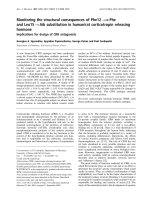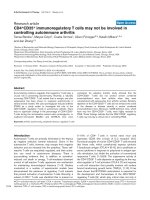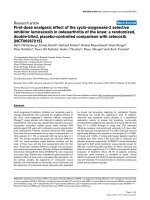Báo cáo y học: "Measuring the anticoagulant effect of low molecular weight heparins in the critically ill" pps
Bạn đang xem bản rút gọn của tài liệu. Xem và tải ngay bản đầy đủ của tài liệu tại đây (30.81 KB, 2 trang )
Page 1 of 2
(page number not for citation purposes)
Available online />Abstract
Antithrombotic prophylaxis in critically ill patients frequently fails.
Venous thromboembolism is associated with adverse clinical
outcomes, including a prolonged intensive care unit stay and
death. A potential mechanism by which critically ill patients may be
predisposed to antithrombotic failure is the inability to achieve
‘prophylactic’ anticoagulant drug levels as a result of impaired
absorption. For example, previous studies have shown that patients
on inotropes have reduced serum levels of low molecular weight
heparin, presumably on the basis of reduced absorption from the
subcutaneous injection site. In the previous issue of the journal,
Rommers and colleagues examined whether subcutaneous edema
reduces absorption of a low molecular weight heparin; although
small, and thus underpowered, the authors failed to find any
relationship between the level of low molecular weight heparin and
the presence of edema. These findings provide reassurance that
subcutaneously administered medications may be used in critically
ill patients with edema.
It is now widely accepted that patients in the intensive care
unit (ICU) are at a high risk of deep vein thrombosis and
pulmonary embolism. Patients who develop these
thromboembolic complications have a higher risk of both ICU
and hospital-acquired morbidity and mortality, including the
need for and the duration of mechanical ventilation, the ICU
and hospital lengths of stay, and, perhaps, death [1]. It is
therefore important that all patients in the ICU receive
effective thromboprophylaxis [2]. In those patients with an
absolute contraindication to anticoagulants, such prophylaxis
should take the form of intermittent pneumatic compression
devices and, perhaps, screening ultrasonography.
In the absence of a contraindication, all patients in the ICU
should receive some form of pharmacologic thromboprophy-
laxis. In most cases this will consist of either unfractionated
heparin or low molecular weight heparin (LMWH). Unfraction-
ated heparin at a dose of 5000 U subcutaneous twice or
three times daily is the preferred anticoagulant in North
America, while LMWH at prophylactic doses is used most
frequently in Europe.
Despite the routine provision of anticoagulant prophylaxis,
failures do occur. For example, in a prospective study of 261
patients performed by our group, 25 patients (9.6%)
developed ultrasonographically detected deep vein thrombo-
sis despite routine and protocol-directed provision of
thromboprophylaxis [1]. This observation suggests that
additional research is required to refine prophylaxis for these
very-high-risk patients.
Failure of pharmacologic prophylaxis may be due to an
overwhelming prothrombotic stimulus or due to inadequate
anticoagulant effect. Critically ill patients may harbor ICU-
specific characteristics that predispose to failure of thrombo-
prophylaxis. Dorffler-Melly and colleagues demonstrated that
critically ill patients receiving inotropic support have
significantly lower peak LMWH levels than similar patients
not exposed to ionotropes [3]. They hypothesize that
impaired tissue perfusion as a result of vasoconstriction
reduces absorption of LMWH. This reduced anticoagulant
effect may in turn predispose to thrombosis.
Many patients in the ICU have extensive subcutaneous
edema. Such edema is due to aggressive fluid resuscitation,
reduced colloid oncotic pressure, renal insufficiency and
tissue trauma associated with injury or surgery. It is
reasonable to hypothesize that subcutaneous edema may
impair absorption of LMWH, thus predisposing to lower peak
heparin levels and an increased risk of thrombosis.
In the previous issue of the journal, Rommers and colleagues
[4] reported results of a pilot study that examined the impact
Commentary
Measuring the anticoagulant effect of low molecular weight
heparins in the critically ill
Mark Crowther and Wendy Lim
St Joseph’s Hospital, Hamilton, Ontario, Canada
Corresponding author: Mark Crowther,
Published: 25 July 2006 Critical Care 2006, 10:150 (doi:10.1186/cc4978)
This article is online at />© 2006 BioMed Central Ltd
See related research by Rommers et al., />IUC = intensive care unit; LMWH = low molecular weight heparin.
Page 2 of 2
(page number not for citation purposes)
Critical Care Vol 10 No 4 Crowther and Lim
of subcutaneous edema on the pharmacokinetics of LMWH.
In this small (total recruitment 14 patients), nonrandomized
pilot study, the authors performed careful pharmacokinetic
analysis of the anti-factor Xa heparin levels found after
subcutaneous administration of 2500 U dalteparin in a group
of critically ill patients. In their study, patients with edema
were defined by at least a 10% increase in body weight and
the appearance of generalized edema. The pharmacokinetics
were compared by examining the peak anti-factor Xa heparin
level and the area under the anti-factor Xa heparin level–time
curve. The authors conclude that there was no difference in
the observed anticoagulant effect; however, the peak levels
were lower than those expected — an observation consistent
with previous publications.
Although small, and thus underpowered, the study of Rommel
and colleagues does provide some reassurance that the
degree of tissue edema found in critically ill patients does not
significantly impact the anticoagulant effect of dalteparin.
Methodologically rigorous conclusions would require a much
larger study, with more explicit control of variables such as
renal function, use of inotropes and baseline-dependent and
time-dependent variables (age, gender and admission
diagnosis) included in a rigorous multivariable analysis. In the
absence of such data, however, the results of this study
should reassure us that subcutaneously administered
medications will be absorbed into the circulation of critically ill
patients. These observations are important for the design of
future studies of both thromboprophylaxis and other
interventions that may require medication to be given by this
route.
Competing interests
This manuscript was not financed in any way. MC has
received honoraria, travel funding, consultancy fees and
research support from Leo Laboratories, Sanofi-Aventis and
Pfizer.
Acknowledgement
MC is a Career Investigator of the Heart and Stroke Foundation of
Canada. WL holds a Sanofi-Aventis/ISTH research award.
References
1. Cook DJ, Crowther MA, Meade M, Rabbat C, Griffith L, Schiff D,
Geerts W, Guyatt G: Deep venous thrombosis in medical–sur-
gical critically ill patients: prevalence, incidence, and risk
factors. Crit Care Med 2005, 33:1565-1571.
2. Shojania KG, Duncan BW, McDonald KM, Wachter RM: Univer-
sity of Califorinia Evidence Based Practice Centre. Making
Health Care Safer: A Critical Analysis of Patient Safety Practices.
Report 01-E058, 1-655. Rockville, MD: Agency for Healthcare
Research and Quality; 2001.
3. Dorffler-Melly J, de Jonge E, Pont AC, Meijers J, Vroom MB, Buller
HR, Levi M: Bioavailability of subcutaneous low-molecular-
weight heparin to patients on vasopressors. The Lancet 2002,
359:849-850.
4. Rommers MK, Van Der Lely N, Egberts TCG, van den Bemt
PMLA: Anti-Xa activity after subcutaneous administration of
dalteparin in ICU patients with and without subcutaneous
oedema: a pilot study. Crit Care 2006, 10:R93.









